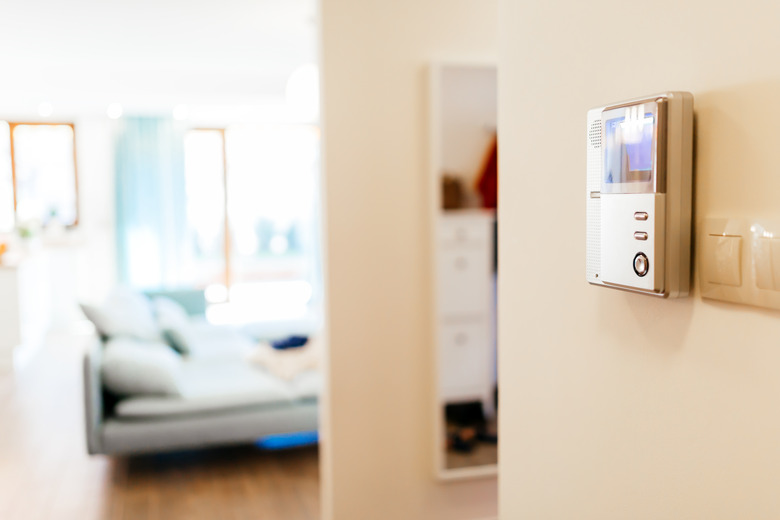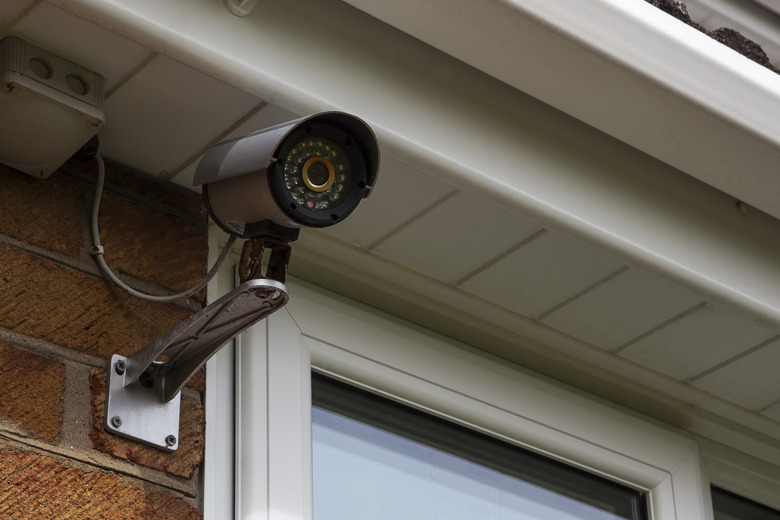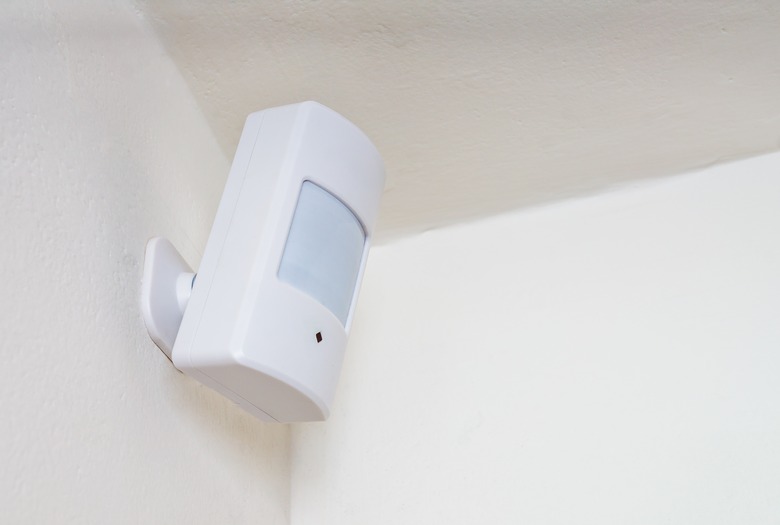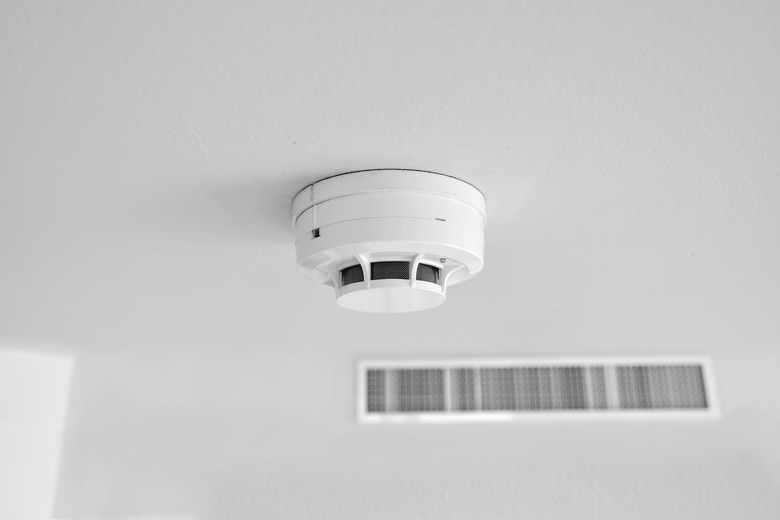The 9 Basic Parts Of A Home Security System
We may receive a commission on purchases made from links.
One of the best ways to increase your peace of mind while at home and away is to install a quality home security system that can help protect you and your property — not just from threats like burglars but also from other dangers, like fires or floods. Not everyone requires the same level of home security, which is why your alarm system should be customized for your needs based on factors such as whether you are a homeowner or renter, your overall budget and your home's fire or flood risk. In fact, some people might find they can meet their security system needs with a few a la carte items, while others might need a more extensive DIY setup, and some people will find that a fully integrated, professionally installed system is the best option.
1. The Master Control Panel
1. The Master Control Panel
A master control panel is where all the information from a central home alarm system is relayed and processed. While those who purchase individual components of their system separately may not have a centralized method to control the system all at once (unless the components are smart home products that are linked on a central app), most people with an integrated home alarm system will have a master control panel of some sort. Those with a monitoring system will generally have their master control panel linked with the alarm company, which will be able to view data from the panel when an alarm is triggered.
If you're thinking of purchasing an alarm system that has a control panel, be sure to look for one with a battery backup. If the power goes out, your home won't become vulnerable.
2. The Access Control Unit
2. The Access Control Unit
The master control panel is generally wired to one or more access control units, with one usually located near the front door so it can be easily accessed when entering and leaving the house. This may be a simple numerical keypad that can be used to turn on the system or enter a code to disarm it. These devices generally feature a panic button that sounds the alarm and may contact the alarm-monitoring company (in monitored systems), the police, the fire department or emergency medical services.
Modern systems may include more complicated digital control units that may also feature smart home automation controls, allowing users to control the lights, thermostat and more. Smart home alarm systems can usually be connected to a phone or tablet app so you can arm or disarm the alarm from anywhere, view the feed from your security cameras, unlock linked smart locks, view data log information and more.
These devices can be particularly helpful for those who want to let people like pet walkers into their home without providing them the ability to control the burglar alarm system. They are also particularly handy when connected to a doorbell camera since they can allow you to see and speak with anyone who rings your doorbell, even when you're away from home.
3. Home Security System Cameras
3. Home Security System Cameras
Security cameras were once prohibitively expensive for most home alarm systems when the only real option was a closed-circuit television connected to a VCR, but since video and storage technologies have dramatically improved over the last few decades, the prices have also gone down significantly. Now that they're more affordable, security cams are a must-have for any good security system.
Cameras can not only deter thieves but they also provide you with an image of a suspect in the event of a break-in, which can play a crucial role in helping police identify the culprit. If you have a live-streaming camera that can be viewed remotely, this can also let you view what's happening in your home at any given time, providing you with an extra sense of security and control over what happens on your property.
Whether you install a doorbell camera like Ring or a more traditional security camera, for best results, look for a cloud-connected device with night vision that allows live viewing through an app. Ensure any camera you purchase has a high enough resolution that you'll be able to identify anyone who commits a crime on your property. An SD card can also be useful to help guarantee you'll have a recording of any events even if your internet goes down, but a cloud service can be handy in case a burglar takes the effort to destroy or steal your camera.
Spend some time thinking about the best location for the device. Be sure to install the camera in an area where you will be able to see the face of any home intruder. Keep in mind that while a camera installed in a conspicuous place may discourage any wrongdoers, this can also tip them off to the fact that you're recording, so they may simply attempt to break your camera, steal it or hide their face to avoid detection. A concealed camera will probably stay safe during a crime.
It's a good idea to install a camera near the front door since this is where most burglars enter, but you may also want cameras inside your home or outdoors leading to your front door or near your fences. Wherever you place cameras, be sure they're properly positioned so you can see everything happening in that area. To maximize coverage of a given area, you may even consider a camera that can pan and tilt.
4. Door and Window Alarms
4. Door and Window Alarms
Door and window sensors are made of a pair of magnetic switches that are triggered when they become separated, which happens whenever the door or window is opened. When triggered, most door and window alarms emit a double beep that notifies you that you have 30 seconds or so to go to the access control unit and disarm the system, or the alarm will be triggered. This delay is crucial in helping to prevent false alarms, which are both annoying and likely to decrease the effectiveness of your system if your neighbors become accustomed to you setting off your alarm accidentally.
Window sensors can be installed in different areas of the window, which can allow for the windows to even be left partially open while still having the alarm active. There are even some special screens that can be installed that will set off the alarm when they have been cut or removed from the window.
These security system components may be considered old-fashioned, but they're both effective and inexpensive, making them a great addition to any burglar alarm system. One of the best things about them is that practically all home break-ins involve entry through a first-floor door or window, so they can help catch most burglars. In fact, one study found that 34 percent of burglars enter a home through the front door, 23 percent go through a first-floor window and 22 percent use the back door. That means that in combination with glass-break detectors that can catch anyone attempting to go through windows or glass doors, you could detect up to 79 percent of all home intruders.
5. Glass-Break Sensors
5. Glass-Break Sensors
Glass breaks at a unique audio frequency, and glass-break detectors are designed to trigger an alarm whenever they hear this particular sound. Alternatively, some sensors can be installed directly on the window itself and can detect the vibrations that occur when the glass breaks. This is a great way to protect your home against burglars who may gain entry by smashing a window or glass door. When purchasing, remember that most glass-break sensors have a range of 20 feet or so, which means you'll need to install one device in every first-floor room with windows or a glass door. Naturally, those that are installed directly on windows need to be installed on every window you wish to protect.
If you're considering installing only a few select security system components, glass-break sensors and window and door alarms are a great combination that will give you a great amount of protection for a low price.
6. Security System Motion Sensors
6. Security System Motion Sensors
Motion detectors can be an effective way to patrol your home while you're away or in bed. As the name implies, these devices trigger an alarm when they detect motion within the home. That being said, because motion sensors can be fooled and often don't cover the entire area of a room, it's not a good idea to base your entire security system on motion detectors. While you might be inclined to think that a motion sensor system is off the table if you have a pet, many models have a pet-immune mode that will ignore movements from animals under a particular weight or size while still going off when a full-size human enters the home.
Each type of motion sensor features a different type of technology, and some even incorporate multiple technologies to increase effectiveness while reducing the risk of false alarms. The most common type of motion detector uses passive infrared sensors to detect body heat. If infrared energy levels change too quickly, however, they will be triggered. It is important to install these devices out of the range of objects that quickly heat up, such as sunny windows, chimneys, ovens and heating vents since they are sensitive to temperature and will become less effective to alerting you when a threat comes along.
The most common motion-sensor technology uses microwave sensors. These detect motion by projecting microwave rays off objects and go off when the rays are interrupted. Area-reflective sensors and ultrasonic sensors work in a similar way using infrared rays and ultrasonic waves in place of microwave rays.
7. Yard Signs and Window Stickers
7. Yard Signs and Window Stickers
There is some anecdotal evidence that burglars may avoid entering a home if they see an alarm system sign in the yard or a sticker in the window. While there may be no hard scientific evidence to back this up, it seems reasonable that a person plotting to break into a home is more likely to enter one that doesn't have a security system than one that does.
That being said, there are some downsides, the first one being that many homeowners do not like the way these signs and stickers look. It's also possible that burglars may think someone with a home security system has better-quality items in the home. Many people put up these perceived deterrents despite not having a home security system at all, so it's possible that a thief may be willing to roll the dice on the chance that the home is protected by nothing more than a sign or sticker.
8. Smoke and Carbon Monoxide Detectors
8. Smoke and Carbon Monoxide Detectors
When most people think about home security systems, they think of something that can eliminate the risk of a break-in, but fires and carbon monoxide poisoning can be far more deadly. That's why it's not a bad idea to incorporate smoke and carbon monoxide alarms into your security system. While most people already have some of these devices in their home, adding a combination smoke and carbon monoxide detector to a home automation system means that you may be notified of an emergency while away from home, so you can call the fire department when there's an emergency or disable the false alarm when there's not.
9. Heat, Temperature and Water Leak Sensors
9. Heat, Temperature and Water Leak Sensors
Beyond simple smoke and carbon monoxide detectors, you can further protect your home from natural disasters by investing in heat, temperature or water leak sensors. A heat sensor will go off when it senses a dramatic rise in temperature, usually more than 15 degrees Fahrenheit per minute, or if the overall temperature exceeds 135 degrees. These heat detectors can provide an extra layer of security on top of a traditional smoke detector.
Going beyond mere heat sensors, temperature sensors will notify you when ambient temperatures go outside of your programmed acceptable ranges. You can use them to prevent freezing pipes when you're away from home for a while or to ensure your wine cellar or freezer is always maintained at an ideal temperature.
Lastly, water leak detectors can help protect you from serious flood damage by alerting you of leaks. They go off when water goes between two contacts within the device. Place them in areas prone to water problems, such as basement floors, near washing machines and hot water heaters or under sinks.
References
- Alarm System Store: Guide to Parts and Components of a Home Security System
- SafeWise: The Beginner's Guide to Motion Sensors
- International Association of Certified Home Inspectors: Burglar-Resistant Homes
- SafeWise: What Are Common Components of a Security System?
- Startupily: 5 Essential Components of a Good Security System
- Better Homes & Gardens: Basic Alarm System Components



